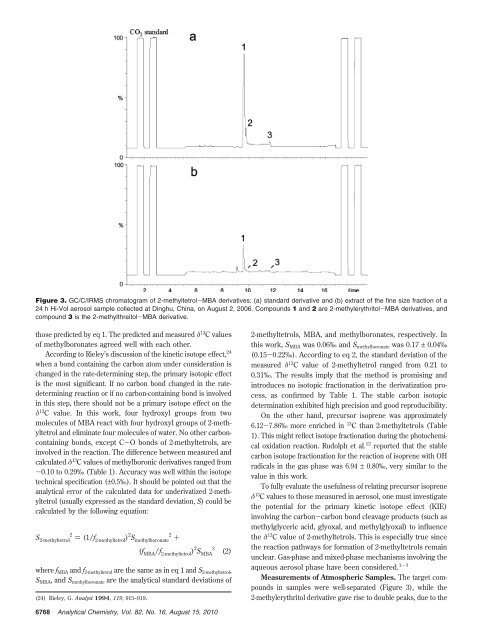Analytical Chemistry Chemical Cytometry Quantitates Superoxide
Analytical Chemistry Chemical Cytometry Quantitates Superoxide
Analytical Chemistry Chemical Cytometry Quantitates Superoxide
Create successful ePaper yourself
Turn your PDF publications into a flip-book with our unique Google optimized e-Paper software.
Figure 3. GC/C/IRMS chromatogram of 2-methyltetrol-MBA derivatives: (a) standard derivative and (b) extract of the fine size fraction of a<br />
24 h Hi-Vol aerosol sample collected at Dinghu, China, on August 2, 2006. Compounds 1 and 2 are 2-methylerythritol-MBA derivatives, and<br />
compound 3 is the 2-methylthreitol-MBA derivative.<br />
those predicted by eq 1. The predicted and measured δ 13 C values<br />
of methylboronates agreed well with each other.<br />
According to Rieley’s discussion of the kinetic isotope effect, 24<br />
when a bond containing the carbon atom under consideration is<br />
changed in the rate-determining step, the primary isotopic effect<br />
is the most significant. If no carbon bond changed in the ratedetermining<br />
reaction or if no carbon-containing bond is involved<br />
in this step, there should not be a primary isotope effect on the<br />
δ 13 C value. In this work, four hydroxyl groups from two<br />
molecules of MBA react with four hydroxyl groups of 2-methyltetrol<br />
and eliminate four molecules of water. No other carboncontaining<br />
bonds, except C-O bonds of 2-methyltetrols, are<br />
involved in the reaction. The difference between measured and<br />
calculated δ 13 C values of methylboronic derivatives ranged from<br />
-0.10 to 0.29‰ (Table 1). Accuracy was well within the isotope<br />
technical specification (±0.5‰). It should be pointed out that the<br />
analytical error of the calculated data for underivatized 2-methyltetrol<br />
(usually expressed as the standard deviation, S) could be<br />
calculated by the following equation:<br />
2<br />
S2-methyltetrol ) (1/f2-methyltetrol ) 2 2<br />
Smethylboronate +<br />
(fMBA /f2-methyltetrol ) 2 2<br />
SMBA where fMBA and f2-methyltetrol are the same as in eq 1 and S2-methyltetrol,<br />
SMBA, and Smethylboronate are the analytical standard deviations of<br />
(24) Rieley, G. Analyst 1994, 119, 915–919.<br />
6768 <strong>Analytical</strong> <strong>Chemistry</strong>, Vol. 82, No. 16, August 15, 2010<br />
(2)<br />
2-methyltetrols, MBA, and methylboronates, respectively. In<br />
this work, SMBA was 0.06‰ and Smethylboronate was 0.17 ± 0.04‰<br />
(0.15-0.22‰). According to eq 2, the standard deviation of the<br />
measured δ 13 C value of 2-methyltetrol ranged from 0.21 to<br />
0.31‰. The results imply that the method is promising and<br />
introduces no isotopic fractionation in the derivatization process,<br />
as confirmed by Table 1. The stable carbon isotopic<br />
determination exhibited high precision and good reproducibility.<br />
On the other hand, precursor isoprene was approximately<br />
6.12-7.86‰ more enriched in 13 C than 2-methyltetrols (Table<br />
1). This might reflect isotope fractionation during the photochemical<br />
oxidation reaction. Rudolph et al. 12 reported that the stable<br />
carbon isotope fractionation for the reaction of isoprene with OH<br />
radicals in the gas phase was 6.94 ± 0.80‰, very similar to the<br />
value in this work.<br />
To fully evaluate the usefulness of relating precursor isoprene<br />
δ 13 C values to those measured in aerosol, one must investigate<br />
the potential for the primary kinetic isotope effect (KIE)<br />
involving the carbon-carbon bond cleavage products (such as<br />
methylglyceric acid, glyoxal, and methylglyoxal) to influence<br />
the δ 13 C value of 2-methyltetrols. This is especially true since<br />
the reaction pathways for formation of 2-methyltetrols remain<br />
unclear. Gas-phase and mixed-phase mechanisms involving the<br />
aqueous aerosol phase have been considered. 1-3<br />
Measurements of Atmospheric Samples. The target compounds<br />
in samples were well-separated (Figure 3), while the<br />
2-methylerythritol derivative gave rise to double peaks, due to the

















